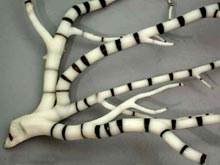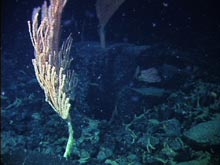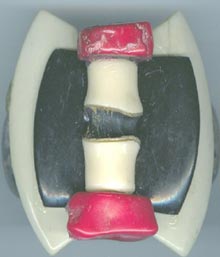
The dried skeleton of a Keratoisis specimen from the Straits of Florida, collected in 2003 by Harbor Branch Oceanographic Institution scientists. Click image for larger view.
Bamboo Corals in North America: Deep-sea Forests and Blue Light
Peter Etnoyer Aquanautix Sponsored by Marine Conservation Biology Institute
What do corals and jellyfish have in common? If you guessed “stinging cells,” you are correct. Corals, jellyfish, and anemones are all members of the Phylum Cnidaria. Corals and anemones are in the same class: Anthozoa.
Corals are divided into two sub-classes, based on whether they have six or eight tentacles on their polyps. Corals with eight pinnate tentacles are in the sub-class Alcyonaria. Of the corals in this sub-class, those with a horny proteinaceous skeleton, such as a sea fan, are in the Order Gorgonacea. Those corals from the sub-class Alcyonaria that have a bony skeleton are in the Order Alcyonacea. Bamboo corals, of the Family Isididae, are one of the most fascinating families of the Order Alcyonacea (Alderslade, 1993).
A Fascinating, Cosmopolitan Coral
Bamboo corals are fascinating. They are cosmopolitan, which means they occur in waters all over the world. They can be immensely abundant, often dominating deep-sea communities and forming large, single-species fields, meadows, or stands. Their fleshy polyps are non-retractile, growing upon a calcareous (containing calcium carbonate) skeleton, alternated by horny gorgonian nodes. The bony internodes are increasingly used in jewelry, both in its natural form (bony white) and as a dyed polished form (pinkish-red). One of the deepest recorded occurrences of all deep-sea corals is a bamboo coral (Keratoisis profunda), which was discovered at 4,851 m.
Another bamboo coral species, the unbranched Lepidisis olapa, is bioluminescent (creates light) when touched (Muzik, 1978). Bioluminescent bamboo corals give off a blue light that shoots up and down the axis. Imagine a forest where the trees light up when you touch them. This is what we find sometimes at the bottom of the sea.
Scientists in New Zealand and Australia have taken bamboo coral colonies 30 ft tall, with “trunks” 13 in across, from seamounts in the region. A 4 ft specimen, sampled from Warwick Seamount on the 2002 Gulf of Alaska cruise, was aged to 70 yrs (B. Roark, in press). Those larger colonies may be 500-years-old.
Hula Skirts
The family Isididae is species-rich (138 known species), with a total of 22 species in four genera documented in North America and Hawaii. Some Isidids have fleshy "hula skirts" of elongated tentacles that could be similar to the “sweeper tentacles” found in shallow-water scleractinian (stony) corals. Sweeper tentacles are elongated and packed with powerful stinging nematocysts to ward off nearby settlers and predators. (Nematocysts are "harpoon" cells that grow in the tentacles of corals, anemones, and jellyfish, and they cause the stings that are common to all the classes in the Phylum Cnidaria.) Only one other species of octocoral and one black coral are documented as having sweeper tentacles, so we will focus a good bit of our attention on this subject during the mission.

The base of a living bamboo coral, Isidella sp., on Warwick Seamount. Notice the long tentacles. We call them "hula skirts," but we don't know exactly what they are. They may be defensive “sweeper” tentacles. Click image for larger view.

This is a side view of Isidella’s planar candelabra structure. Notice another bamboo coral in the background and the rocky substrate covered with worm tubes. Click image for a larger view.
Deep-sea corals can occur in many different types of assemblages, just as trees occur in different types of forests. Deep-sea coral-reef types include single-species hard-coral reefs (e.g., Lophelia sp. in the North Atlantic), single-species-dominant soft-coral fields (e.g., the Primnoid Callogorgia sp. or Isidid Acanella sp. in the Gulf of Mexico), or diverse rocky reefs of octocorals, anemones, and sponges (e.g., Aleutian Islands). On this expedition, we will keep a sharp eye out for monotypic (single-species) fields of octocorals. We will look at the communities of fish, crabs, sea stars, and urchins associated with these large stands of deep-sea corals, and we will study the relationships between the abundance of corals and the abundance of associated species.
New Samples, Better Identification
Our current knowledge of octocoral systematics can hardly match our enthusiasm for these cold-water reefs. In the past, trawlers did most of our scientific collecting. The National Museum of Natural History at the Smithsonian Institution is filled with broken fragments of dead corals, but it contains very little preserved tissue. Scientists need the preserved tissue, with its bony, microscopic sclerites, to identify most octocorals to species level.
During this cruise, we will be collecting many types of deep-sea corals, documenting the living polyps of octocoral colonies, and discerning their sclerites for species-level identifications on shore. Watch for more articles on deep sea-corals throughout our expedition to the Gulf of Alaska seamounts!
(top)

























